Content
Kinematics: Relative Translation Motion
Relative Independent Motion of Two Objects under translation
Inertial Reference Frames
Kinematics: Relative Translation Motion
When several objects moving in curvilinear motion, these objects can also be related to each other. Usually, the system of objects are measured by a single time system with the same measurement dimension. However, when objects move in a system more than one dimension, the orientation of object should also be considered because the rate of change of a vector function for an object as observed from a moving object may be different from the rate of change of the object as observed from a fixed frame of reference.
Relative Independent Motion of Two Objects under translation
In simple curvilinear motion, the orientation of an object does not change during the motion along the path. In other words, the object is in translation motions simultaneously along the axes of reference frame of the object which is always parallel to the corresponding axes of a fixed frame of reference.
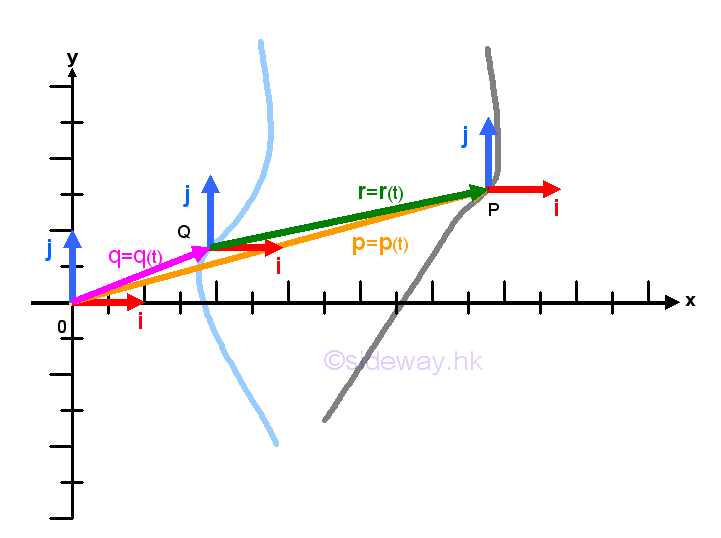
Since the position vector of a point with respect to the fixed frame of reference, that is the origin O, changes according to the position of the point, the position vector with respect to the fixed frame of reference is also changed with respect to a moving frame of reference. Because the orientation of frame of reference of the moving object does not changed, the relative position of an object as observed from a moving object can be obtained by deducing the position vector of the moving object with respect to the fixed frame of reference from the position vector of the observed target object with respect to the fixed frame of reference as in one dimensional motion. Imply
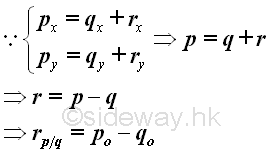
However, the rate of change of a vector function, observed by the fixed frame of reference, does not change, when the frame of reference of the observing point is in translative motion, where the axes of the frame of reference of the observing point are always parallel to the corresponding axes of the fixed frame of reference.
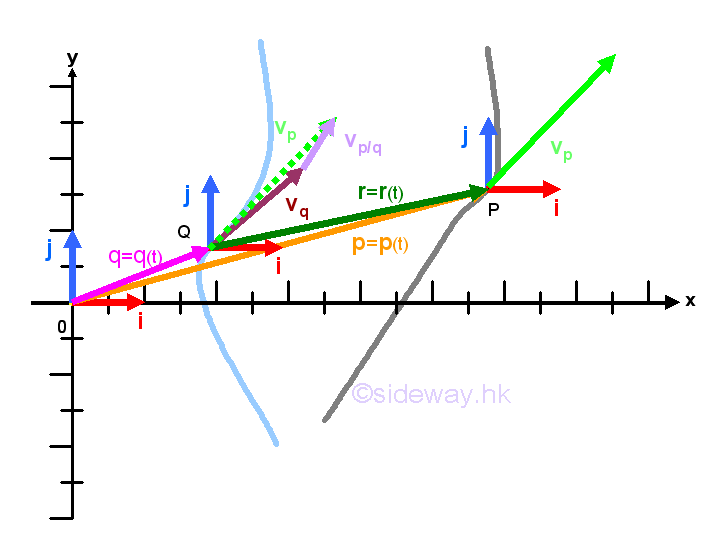
Since the rate of change of a vector at a point with respect to the fixed frame of reference, that is the origin O, is only a relative relationship between two component functions, the rate of change of a vector depends only on the orientation of the frame of reference not the origin of the frame of reference. Therefore the velocity vector does not change when the fixed frame of reference is translated. And thus for objects that are in translation, the relative velocity of an object as observed from a moving object can be obtained by deducing the velocity vector of the moving object with respect to the fixed frame of reference from the velocity vector of the observed target object with respect to the fixed frame of reference as in one dimensional motion. Imply
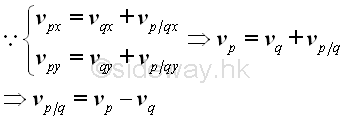
Similarly, the rate of change of a velocity vector at a point with respect to the fixed frame of reference, that is the origin O, is only a relative relationship between two component functions, the rate of change of the velocity vector depends only on the orientation of the frame of reference not the origin of the frame of reference.
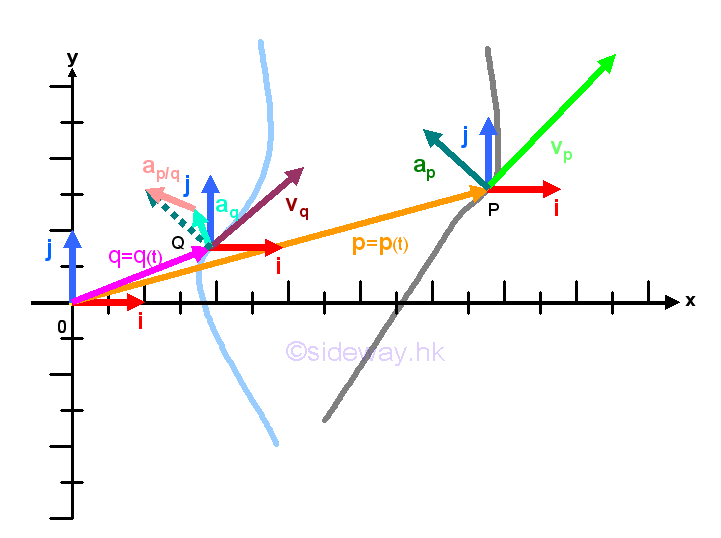
Therefore the acceleration vector does not change when the fixed frame of reference is translated. And thus for objects that are in translation, the relative acceleration of an object as observed from a moving object can be obtained by deducing the acceleration vector of the moving object with respect to the fixed frame of reference from the acceleration vector of the observed target object with respect to the fixed frame of reference as in one dimensional motion.
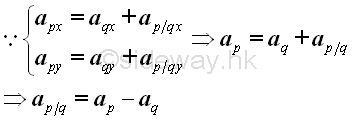
Inertial Reference Frames
The coordinate system used as the frame of reference to measure the object is called inertial reference frame, which is a rigid system without acceleration such that the Newton's laws of motion are always valid. The surface of the Earth can be considered as an inertial frame for most engineering problems because the daily rotation is quite slow.
©sideway
ID: 140300001 Last Updated: 3/5/2014 Revision: 0 Ref:
References
- I.C. Jong; B.G. rogers, 1991, Engineering Mechanics: Statics and Dynamics
- F.P. Beer; E.R. Johnston,Jr.; E.R. Eisenberg, 2004, Vector Mechanics for Engineers: Statics
Latest Updated Links
- Travel Singapore Sight Space(last updated On 12/30/2025)
- Travel Singapore Sight Curiosity Cove(last updated On 12/30/2025)
- Travel Singapore Sight Night Safari(last updated On 12/30/2025)
- Travel Singapore Sight River Wonders(last updated On 12/30/2025)
- Travel Singapore Sight Rainforest Wild ASIA(last updated On 12/30/2025)
- Travel Singapore Sight Singapore Zoo(last updated On 12/30/2025)
- Travel Singapore Sight Mandai(last updated On 12/30/2025)
- Travel Singapore Sight Bird Paradise(last updated On 12/30/2025)
- Travel Singapore Sight AltitudeX(last updated On 12/30/2025)
- Travel Singapore Sight(last updated On 12/6/2025)
- Travel Singapore Rail Network(last updated On 12/5/2025)

 Nu Html Checker
Nu Html Checker  53
53  na
na  na
na
Home 5
Business
Management
HBR 3
Information
Recreation
Hobbies 9
Culture
Chinese 1097
English 339
Travel 31
Reference 79
Hardware 54
Computer
Hardware 259
Software
Application 213
Digitization 37
Latex 52
Manim 205
KB 1
Numeric 19
Programming
Web 289
Unicode 504
HTML 66
CSS 65
SVG 46
ASP.NET 270
OS 431
DeskTop 7
Python 72
Knowledge
Mathematics
Formulas 8
Set 1
Logic 1
Algebra 84
Number Theory 206
Trigonometry 31
Geometry 34
Calculus 67
Engineering
Tables 8
Mechanical
Rigid Bodies
Statics 92
Dynamics 37
Fluid 5
Control
Acoustics 19
Natural Sciences
Matter 1
Electric 27
Biology 1
